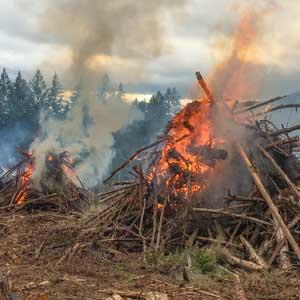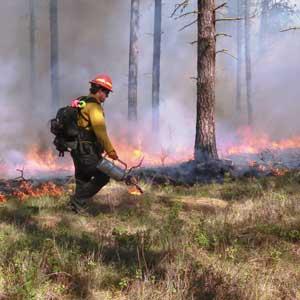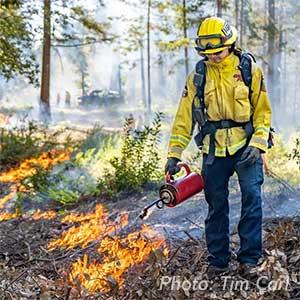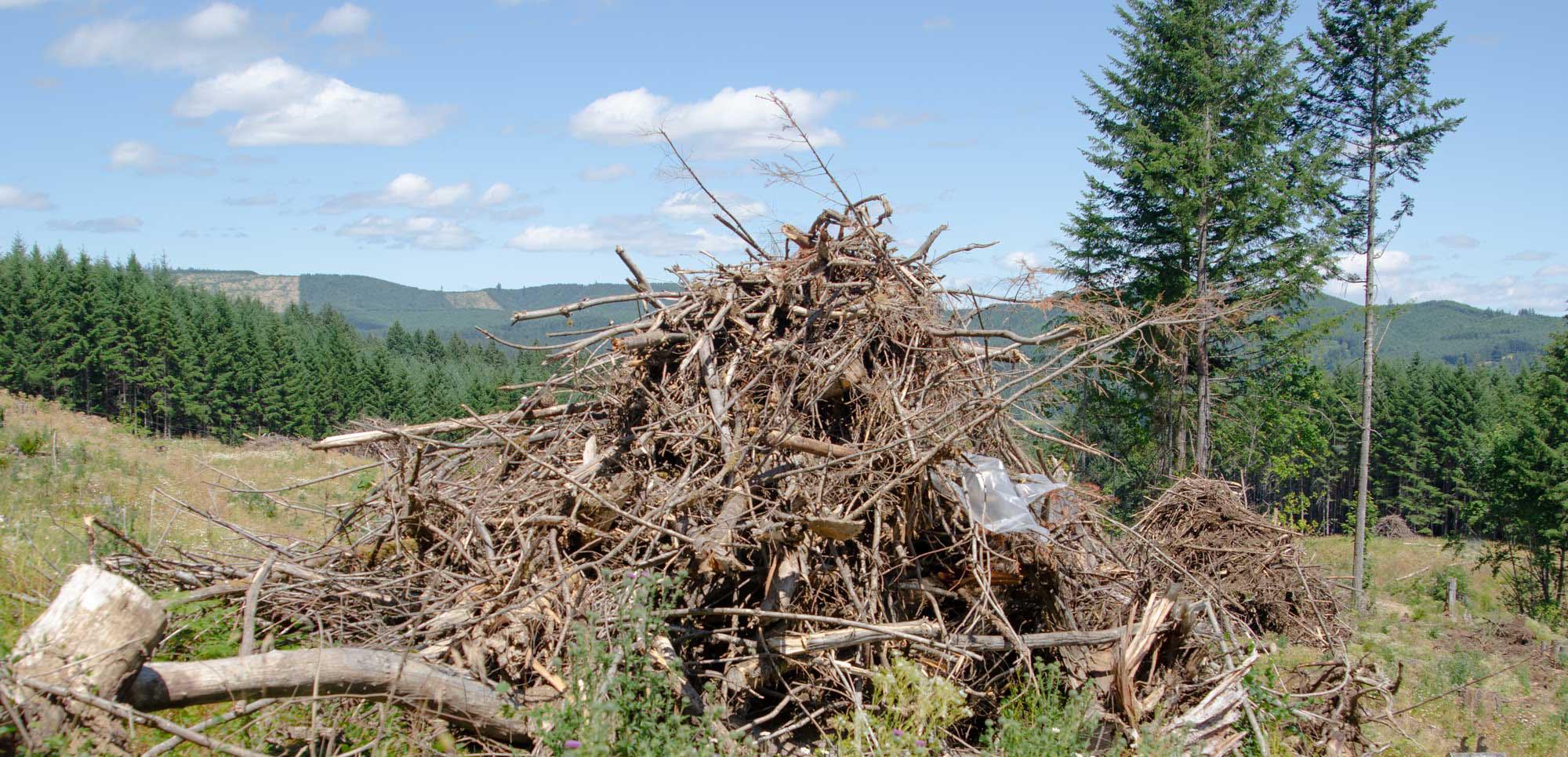Managing forest slash and using prescribed fire are essential practices for maintaining healthy, resilient forests in Oregon. These techniques not only help reduce wildfire risks but can also support ecological restoration, improve wildlife habitat and promote nutrient cycling.
Explore this page to learn more about what slash is, why it’s created and the various management techniques available, including the use of prescribed fire. Understanding these tools can help you make informed decisions for sustainable forest stewardship.
What is slash?
Slash refers to the residual branches, tree tops and other woody debris left on the ground after logging, thinning or other forest management activities. While it is a natural byproduct of forestry operations, excessive slash can be a hazard that increases the risk of wildfire. It can also make accomplishing reforestation goals difficult.
Why is slash created?
Slash is created as part of the process of harvesting timber, thinning overcrowded forests or clearing land for other uses. It is an inevitable part of managing healthy and productive forests. Slash material can also accumulate when woody debris is downed by natural processes such as windstorms, tree die-off or disease. While both types of slash can provide benefits, such as habitat for wildlife and nutrients for soil, excessive accumulation, especially following a logging operation, must be managed to reduce wildfire risk and maintain forest health.
How can you manage slash?
Several techniques are used to manage slash effectively, depending on site-specific conditions and objectives. Approaches include:
- Pile burning: Concentrating slash into piles and burning them under controlled conditions.
- Broadcast burning: Burning slash spread evenly across the forest floor.
- Mastication or mulching: Mechanically breaking down slash into smaller pieces to reduce fire hazards.
- Chipping or grinding: Turning slash into chips for use as biomass fuel or other products.
- Strategic piling: Leaving concentrated piles of unburnt slash in locations with low fire risk, or where they can serve as wildlife habitat sites.
- Biomass utilization: Converting slash into bioenergy, wood products or compost.
- Air curtain incineration: Burning woody debris using a high-efficiency system with reduced smoke emissions and the option for creating biochar.
What is prescribed fire?
Prescribed fire is the intentional use of controlled burns to achieve specific forest management objectives. This practice has been used for centuries and has deep roots in Indigenous land stewardship practices. Indigenous communities have long utilized fire as a tool to manage landscapes, promote ecosystem health and sustain wildlife habitats.
Today, prescribed fire remains a critical tool for reducing hazardous fuels, maintaining forest health and improving wildlife habitat, building upon these time-honored practices while incorporating modern techniques and safety protocols.
Types of prescribed fire

Pile burning: Slash is collected into piles and burned under specific weather and safety conditions.

Broadcast burning: Fire is applied across the forest floor to consume scattered slash and rejuvenate the ecosystem.

Understory burning: Controlled fire is applied to the forest understory, clearing out smaller vegetation while preserving mature trees.
Why is prescribed fire useful?
Prescribed fire reduces the risk of catastrophic wildfires by eliminating excess fuels, improves forest health by promoting nutrient cycling, and supports ecosystems that depend on periodic fire. Additionally, prescribed burns are essential for certain species and habitats, such as oak savannas and fire-adapted plants.
The Oregon State University Extension Fire Program offers the Prescribed Fire Basics collection, a series of introductory-level modules designed to enhance understanding of the importance and mechanics of prescribed burns. These modules provide valuable insights into fire’s role in Oregon’s managed landscapes. Learn about the benefits of prescribed fire, how it’s applied and the key steps involved in planning and implementing controlled burns. Explore the complete collection of modules at the Prescribed Fire Basics webpage.
Smoke management considerations
All fire, whether natural or prescribed, creates smoke, which must be carefully monitored to minimize public health impacts and maintain air quality. In Oregon, unique factors such as inversion layers can occasionally trap smoke closer to the ground, making thoughtful management even more important. Prescribed fire remains a critical forestry tool for reducing wildfire risk and maintaining healthy forests. Oregon’s Smoke Management Plan aims to ensure that prescribed burns are conducted responsibly, balancing the need for proactive forest management with community health and air quality standards. Learn more about the Oregon Smoke Management Plan by visiting the Oregon Department of Forestry’s Burning and Smoke Management webpage.
Emission reduction techniques
Forest managers use various strategies to reduce smoke emissions from prescribed fires. They include:
- Burning under optimal weather conditions: Ensuring efficient combustion and minimizing smoke production.
- Using slash pile covers: Covering piles to keep them dry, which helps ensure more complete combustion and reduces smoke output.
- Reducing fuel loads prior to burning: Strategically lowering the amount of material burned to limit emissions.
While prescribed fire is an effective option and some of Oregon’s forests even depend on fire for regeneration and ecosystem health, there are times when burning may be restricted due to weather, air quality concerns or regulatory requirements. In these cases, other techniques may be more suitable — such as mulching, using an air curtain incinerator or leaving some slash in place to provide wildlife habitat.
ADDITIONAL RESOURCES:
PUBLICATIONS
Managing Logging Slash Piles in Northwest Oregon
The goal of this publication, produced by the Oregon Forest Resources Institute, is to reduce fire hazards on the landscape by assisting landowners with safely creating and burning slash piles.
Prescribed Burning and Smoke Management brochure
A landowner publication on prescribed burning and smoke management developed by the Oregon Department of Forestry’s (ODF) smoke management team.
Forestland Burning Guide
A publication for landowners on prescribed burning and smoke management developed by ODF’s smoke management team.
VIDEOS
FIRE — Fire Ecology of Oregon Forests
A series of web-based presentations on fire ecology.
FIRE — Fire, Fuels and Density Management
Explore this webinar series, where Oregon State University (OSU) Extension forestry and fire experts delve into thinning, fire risk management, fuel reduction impacts, rangeland strategies and high-elevation whitebark pine conservation.
Managing Your Forest with Fire in Mind — Part 1
Learn about the diverse wildlife found across Oregon’s forests, tools for managing habitat at different forest ages, how management actions benefit wildlife across the landscape, and ways to align priority habitat actions with landowner objectives.
Managing Your Forest with Fire in Mind — Part 2
Discover the key factors driving wildfire seasons and explore practical strategies for managing your forest with fire resilience in mind.
Prescribed Fire in Oregon
Prescribed fire in Oregon is a time-honored practice, rooted in the state’s history of Indigenous land stewardship, that is now used as a modern tool to reduce wildfire risks, enhance forest health and support resilient ecosystems.
Wildfire in Your Forest Future
Learn more about wildfire risk in your neighborhood, whether it’s worsening and what can be done to address it, including insights from experienced fire scientists and firefighters.
OTHER
ODF’s Prescribed Fire & Certified Burn Manager Program
ODF’s prescribed fire and certified burn manager program website.
Department of Environmental Quality’s Smoke Management for Prescribed Burning on Forestlands
DEQ’s smoke management for prescribed burning on forestlands website.
OSU Extension Fire Program
The Fire Program uses outreach, education and engagement to foster fire-adapted communities and resilient landscapes through place-based partnerships.

